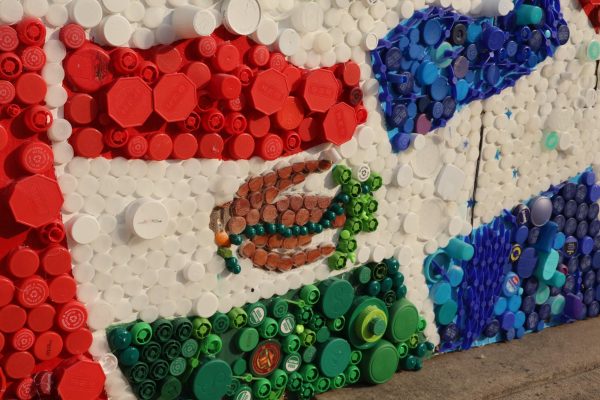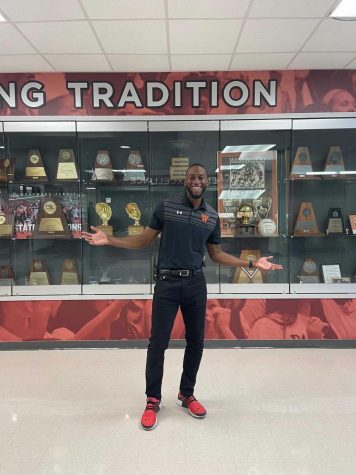‘A Medical Miracle’: Matthew Moore ’18 Survives Against All Odds
Matthew cites PROS as motivation for unprecedented recovery from life-threatening car accident
“They always tell these type of patients that you need a light at the end of the tunnel that you’re focusing on, without that there’s no motivation to work hard.”
It was a long tunnel for Matthew Moore ‘18. A night drive to Whataburger on Feb. 4, 2017 quickly took a turn for the worse when his car came crashing into a tree at 50 mph. What resulted was a 10-day coma caused by the worst brain injury possible, in addition to bones broken in more than 20 different places.
“Parents will tell you that when there are police at the door, they don’t need to say anything,” Bianca Bentzin, Matthew’s mother, said. “You just know. I didn’t wait for them to say anything. I just said, ‘Well, where is he?’”
It was only by chance that Matthew had been rushed into the hospital in the first place. At 3 a.m. along a pitch black street, Matthew was pinned in his car, unconscious and slumped over the horn. Half an hour later, a young couple driving home from Whataburger happened to notice the reflective tape on a car leaning into a ditch.
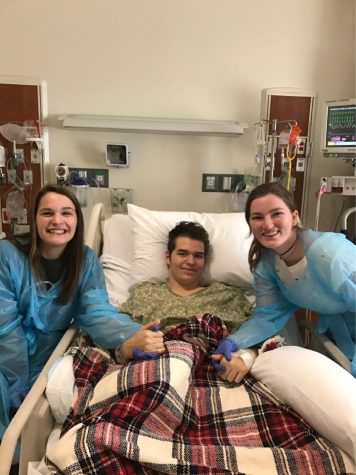
“The guy that we bought the car from, he was super paranoid about something ever happening. He put all these extra features in,” Matthew said. “On the very back of the car he put a huge piece of reflective tape that was probably like a foot by 4 feet, covering the whole entire bottom bumper. So the only reason why [the couple] saw me was because of that.”
Thankfully though, Matthew was alive, largely due to the fact that he was wearing his seat belt.
“He would have hit the windshield. I’m just glad that my insistence that he wear a seatbelt paid off,” Ms. Bentzin said. “There was a friend of ours from his boy scout troop that had died. It was the exact same crash, he slid driver’s side into a tree and he died. Unfortunately the difference was his seatbelt. Matthew had his seatbelt on.”
However once the paramedics arrived at the scene, they struggled to get to Matthew, who was trapped from the damage to the car. After breaking every piece of glass, cutting off the passenger side door, cutting the roof, and expanding the car, the end of the golden hour for trauma was dangerously approaching. The firefighter who eventually reached Matthew resorted to “wiggling and pulling me out finally, which he pulled me out with so much force that I lost a shoe,” Matthew said.
“If you can get to a trauma center within an hour of an event, your chances of survival skyrocket,” Ms. Bentzin said. “He ultimately got to the hospital at about an hour and a half later.”
Because the large majority of his injuries were internal, Matthew was rushed into surgery to first stop the bleeding and keep him alive. Fortunately his broken pelvis just missed his main artery, keeping Matthew from bleeding out in less than three minutes, though there were still several severed vessels that resulted in blood loss. The second surgery occurred following Matthew’s diagnosis of a diffuse axonal brain injury.
“When you have that kind of brain injury, about 90 percent of people don’t wake up ever,” Matthew said. “The problem that gave me an even lower rate of survival was that the part of my brain that was damaged the most was the part that controls sleep. So the problem we had was I physically got stable after about five days, but I was still in a coma.”
The 10 days Matthew was in a coma proved to be some of the most difficult for his family. His younger sister’s birthday was the day after Matthew had gotten into his accident, so she decided to have her birthday party in the hospital room.
“She spent the whole entire party just looking at me in my coma,” Matthew said. “She spent the whole time hugging me or just sitting on my bed with me.”
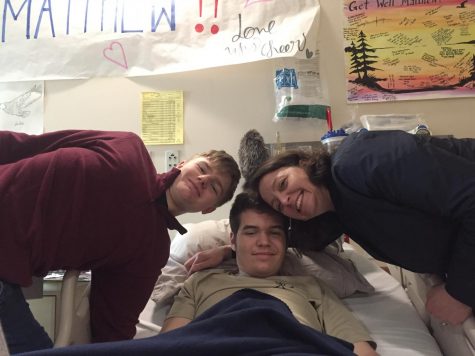
Because of the unpredictability of the brain, doctors told Ms. Bentzin the result could be anything from Matthew never waking up to a full recovery.
“You’re fighting this demon in your head all day long of worst case scenario,” Ms. Bentzin said. “Everyday is just waking up, staring at the monitor of numbers, watching the numbers. You just become tunneled vision; your whole outside world stops. All that matters are these four walls and what’s going on inside it.”
Since brain swelling maximizes at three days, it was after that time that Ms. Bentzin began to realize the chance of Matthew waking up. However, Matthew’s extent of brain function was another question posed by how unpredictable the brain can be.
“That’s what I remember struggling with the most,” Ms. Bentzin said. “It wasn’t if he wouldn’t wake up from his coma, my biggest fear was that he would wake up and not have the kind of life he wants, not have the quality of life he deserves.”
Towards the end of the 10 days, the doctors discussed the possibility of removing the intubation tube Matthew had by performing a tracheotomy, since an intubation tube could only be used for 12 days before it would cause permanent damage to the throat. Neither Benztin nor Matthew wanted the tracheotomy.
“He must have heard us talking about it for three days straight because it was the next morning at 9 a.m. that he was supposed to get his trach,” Ms. Bentzin said.
At midnight on Feb. 14, Matthew woke up from his coma only to almost die again.
“They strapped my arms down, but I somehow did a sit-up and grabbed the intubation tube with my hand and sat back down and pulled it out that way,” Matthew said. “That was really bad because they didn’t know if I could breathe on my own because I hurt my brainstem, which deals with basic living, so they were really concerned about that, talking about getting an emergency tracheotomy.”
Much to the relief of both Ms. Bentzin and Matthew, his blood gas held and showed that he could breathe on his own.
“I remember my first thought was, ‘Of course he pulled out his tube, that’s exactly something Matthew would do,’ because he wants his life to be the way he wants it to be,” Ms. Bentzin said. “It’s why I refused to leave the hospital, because I wanted to be there when he woke up, and there we were.”
Though an encouraging moment, waking up from his coma was only the beginning of an extensive tunnel. He was transferred to an inpatient care hospital, where he underwent intense rehabilitation to relearn basic functions ranging from speaking to going to the bathroom.
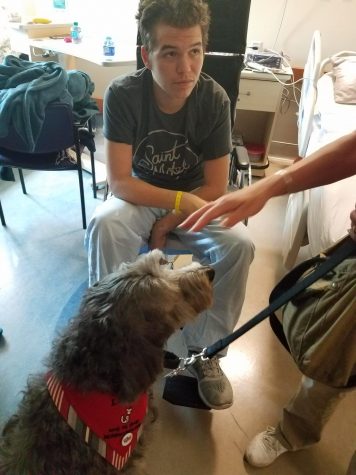
“My determination to get back, honestly my main thing was always PROS [Peers Reaching Out and Sharing],” Matthew said. “Just going back and seeing my kid was something that pushed me every single day.”
With the idea of returning to his PROS campus fueling him, Matthew completed his inpatient rehabilitation sessions in an unprecedented amount of time; an expected stay of three months was reduced to a mere 15 days.
“He wanted to get back there,” Ms. Bentzin said. “His biggest worry was that his [PROS] kid that he was assigned to at his campus thought he had just dropped them. He wanted somebody to tell them that what happened because he didn’t want them to think he didn’t care. ”
Matthew’s rapid recovery ultimately brought a downside. With one of the worst brain injuries, it was difficult for Matthew to interact with other patients who had comparatively minor injuries yet were not recovering nearly as well.
“What still plagues me today is I remember the second hospital so well that I remember all the kids who were there,” Matthew said. “It’s kind of a survivors’ guilt, just that these kids all have something so minor compared to you, and you fully recovered and they can’t speak or can’t think.”
PROS continued to be a driving factor even after Matthew was released from the hospital. Fearing that he wouldn’t have space in his schedule to take PROS after missing so much class, he sped through three credits of geometry, chemistry, and English in three weeks of summer school.
“He wasn’t going to have room in his schedule for PROS as a senior if he didn’t get caught up because he would have to use his senior blocks for his junior classes that he needed to finish,” Ms. Bentzin said. “He just loves helping kids, so he loves the PROS program, so for him again that became the motivator.”
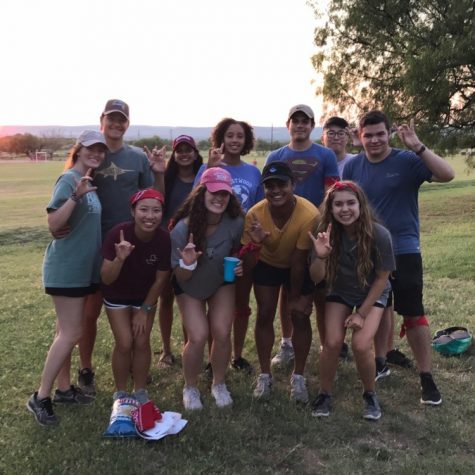
Matthew’s improved school performance has inspired him to return to the dream of becoming a doctor.
“[I guess learning about] taking things for granted, but also it just comes down to I don’t know why. I don’t know why now I’m a good student,” Matthew said. “But now my grades are good and now I can be a doctor. I have a GPA of 3.5 which came back from a 1.4.”
His sense of giving back is another change Ms. Bentzin has noticed before and after the accident. From donating blood to helping others as a doctor, Matthew strives to help and better his community.
“He has a tremendous sense of wanting to give back,” Ms. Bentzin said. “He’s calculated how many times he needs to give blood to make up for all the blood he was given in the ER (emergency room). He’s figured out how many times he needs to go. It’s changed the trajectory of his career goals. He’d like to be an ER doctor now; he’d like to help families through that stuff.”
A year later, Matthew and his family continue to recover from the accident through rebuilding trust and allowing each other to heal at their own paces. Despite the losses endured from such a devastating accident, Ms. Bentzin finds comfort in choosing to see the good.
“When I see all the gains he’s made and all the ways he changed in such wonderful ways, it makes me realize that good things can come out of terrible situations,” Ms. Bentzin said. “That there’s always a silver lining to every crisis, and we just have to be patient and wait for it.”

I've always been a storyteller, and I fell in love with journalism as an outlet to express my voice and share stories. When I'm not in the newsroom, you...




